HOME
DISINFORMATION
PLUNDER
PLUNDER VICTIMS
PEOPLE
GREENBERG
Forged in a hurry: The Puckering Parader, and other reasons for disbelieving what we see
The following information concerning the "Marchuk pointing photograph" was received by email on 19-Feb-2004, and is greatly appreciated. Although the question addressed concerns only the detail of the kind of pistol Ivan Tkachuk may be holding, all such details are of interest, because ultimately they contribute toward answering the very important question of whether there ever was any "Ivan the Terrible of Treblinka."
Dear Sir,
On this page: http://www.ukar.org/greenb03.html your conclusion is that Tkachuk's pistol is a forgery: "The real pistols have prominent front sights; the Tkachuk pistol does not. The real pistols have a complex silhouette; what can be seen of the Tkachuk pistol silhouette is too simple to be credible,..."
To anyone familiar with German WWII guns, the silhouette of Tkachuk's gun is unmistakably that of a Mauser HSc. In fact your description of its features, based upon the photo is quite accurate; the front sight, so small that it is invisible at most angles, the smooth silhouette (an important feature for a 'pocket gun'), the glare coming from the ejector port on the slide (or housing as you call it) the only feature one would expect to be visible on the right hand side of this gun, and the fact that the Mauser HSc is very different from other German handguns of its days. What's more; the Mauser HSc was popular with German police, guards, as personal guns for the staff of organizations like the Organisation Todt, and above all with men with small hands. Due to its small size the HSc was also issued in large numbers to the Luftwaffe and the Kriegsmarine.
Mauser HSc, right hand side:
Another interesting detail to someone who has shot an HSc is the way this small gun rides in your hand. It rides high, with the grip fastened by the middle finger and the ring finger. In this respect the picture looks very real. Based upon my own experience with these guns, I would say it looks as if that man is holding a Mauser HSc with a standard magazine (as shown above). The picture of Tkachuk may or may not be a forgery, but as for Tkachuk's gun being forged your arguments are rather less convincing than the picture itself. An exception to a most interesting site.
Best regards,
[...]
Oslo, Norway
|
Further to the above discussion is the email received 21-Jan-2005:
|
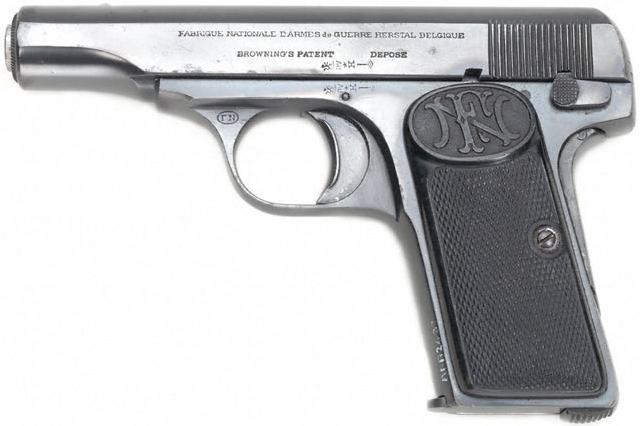
|
Dear Sir,
With regard to the type of pistol that Tkachuk is holding, it appears to me to be the Browning Model 1910, rather than the Mauser HSC as your Oslo correspondent suggested.
Pictures of the Browning 1910 are easily found through Google or other searches � one site is
www.nmm.ac.uk/collections/displayRepro.cfm?reproID=E8703%2D1&picture;=1#content � and you can see that it has a smooth silhouette, a thick, almost rounded barrel at the muzzle end, and there is no fore sight.
Also, you can see in the Tkachuk picture that there is projection of the barrel beyond the end of the upward slant of the gun's frame visible from his index finger inside the trigger guard � this construction matches the Browning. However, the similar upward slant on the Mauser's frame goes from the trigger guard section right to the end of the barrel, and there is therefore no such projection of the barrel.
The Browning was produced in large quantities � with a modified 1922 version eventually superceding it � and can be found all over the world : in fact, one was actually the weapon used to assassinate Archduke Franz Ferdinand, and Brownings (of unconfirmed models) were used in the killings of Rasputin and the Romanovs. With regard to Tkachuk's possible possession of a Browning 1910, the pistol could have originated from either a Soviet source or a German source in this region in WWII.
I make no conclusions regarding the possibility of picture forgery, simply the identification of the gun in question, and have found your site most interesting.
Yours,
George Rodger
|

|
|
Discovered 22-Jan-2005 on the UNIAN web site, the pattern of reflection on this semi-automatic consisting of more than a single round gleam reinforces conclusions drawn below concerning the possibility that the gun in the "Marchenko pointing photograph" is forged.
Irving Greenberg, Chair
United States Holocaust Memorial Council
United States Holocaust Memorial Museum
100 Raoul Wallenberg Place SW
Washington DC 20024-2126
Irving Greenberg:
My letters to you of 04-Sep-2000 and 29-Jan-2001 called your attention to the misuse of the Waiting in Line photograph. In the present letter, I extend that discussion to the doctoring and forgery of graphic images in seven different instances, all of them touching � directly or indirectly � on the Jewish holocaust. One of these seven instances will be the Waiting in Line photograph, of which five different versions, originating from four different sources, will be examined.
(1) The Commissar Vanishes
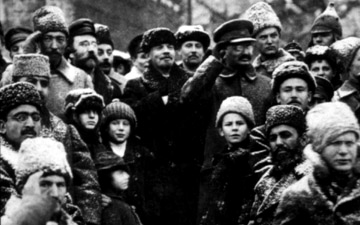 The Newseum: The Interactive Museum of News presents the documentary, The Commissar Vanishes: The Falsification of Photographs in Stalin's Russia), in which examples are offered of Soviet doctoring of photographs. I have placed two of these photographs into the animated image on the left so as to facilitate perception of the differences between them. It can be seen that not only has Trotsky been removed from Lenin's left, but three other individuals have been purged along with him.
The Newseum: The Interactive Museum of News presents the documentary, The Commissar Vanishes: The Falsification of Photographs in Stalin's Russia), in which examples are offered of Soviet doctoring of photographs. I have placed two of these photographs into the animated image on the left so as to facilitate perception of the differences between them. It can be seen that not only has Trotsky been removed from Lenin's left, but three other individuals have been purged along with him.
This instance of photographic forgery is relevant to the Jewish holocaust in that most of the evidence for the Jewish holocaust originated as Soviet war propaganda. Thus, the very same Soviet intelligence agencies that created the vanishing Commissar are the ones who originated the stories of soap made from Jewish fat, the Katyn Forest massacre perpetrated by the Germans, the 870,000 killed at Treblinka, and so on, which have by now either come to be recognized as false, or are well on their way to becoming recognized as false.
Evident in the comparison which is facilitated in the animation are some common symptoms of primitive forgery � namely heightened contrast (lots more black and white) and thus loss of detail (eyes are plunged into blackness) to the point of introducing sizeable regions containing no detail (where material has been removed).
However, to go away with the impression that doctoring photographs was a characteristic only of Stalinist Russia would be incorrect. The same kind of doctoring continues around us to this day, as will be demonstrated below.
(2) The Puckering Parader Picture
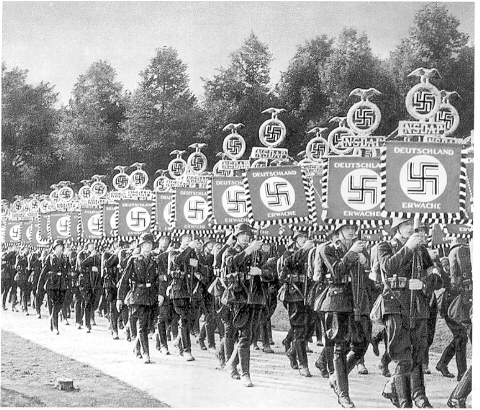 On the left appears to be a photograph of a Nazi military parade presented by Keith Simpson, Waffen SS, Bison Books, London, 1990, p. 6. What appears to be the same photograph is presented also as the frontispiece in Gordon Williamson, The SS: Hitler's Instrument of Terror, Motorbooks International, Osceola WI, 1994. However, placing a fragment from each of these within the animation below suggests that what appeared to be photographs are closer to drawings or paintings, perhaps superimposed on some original photograph.
On the left appears to be a photograph of a Nazi military parade presented by Keith Simpson, Waffen SS, Bison Books, London, 1990, p. 6. What appears to be the same photograph is presented also as the frontispiece in Gordon Williamson, The SS: Hitler's Instrument of Terror, Motorbooks International, Osceola WI, 1994. However, placing a fragment from each of these within the animation below suggests that what appeared to be photographs are closer to drawings or paintings, perhaps superimposed on some original photograph.
Viewing the animation leaves the impression that the Simpson photograph (on the left) was doctored, as for example by having the ERWACHE drawn in, or emphasized, on the banners, by having an implausible mustache put on the leading soldier in the animation, and an even more implausible lip pucker (after which the photograph is named) � almost as if he were wearing dark lipstick � drawn on the soldier behind him, by having the chin straps thickened on both of these soldiers, and on and on.
The Williamson version (the more blurred one), however, is certainly not an undoctored original either, as is evident in the cartoon-like faces and primitively-rendered hands grasping poles.
Although the present case cannot be seen to have the same malevolent intent as the case of the vanishing Commissar, the existence of two doctored versions of the same photograph � or perhaps of the same painting � invites visions of retouchers routinely called in to improve or clarify historical images, and so being available also for doctoring when the intent is to mislead or deceive.
Another conclusion invited by the present example is that enlargement reveals significant detail. The forger, we expect, will want to conceal significant detail, and so will present images as small as he can get away with.

(3) The Warsaw Umschlagplatz Picture
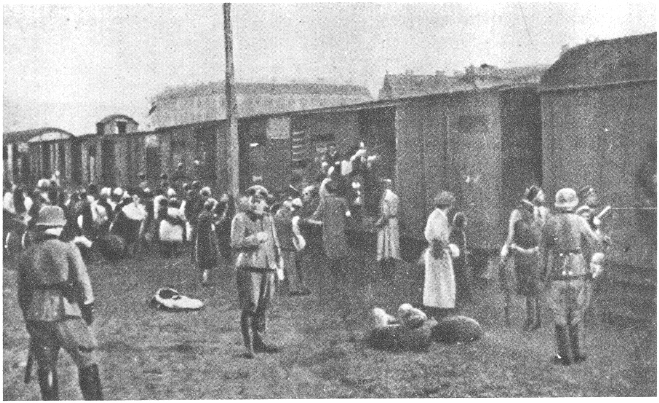 Nora Levin, (The Holocaust: The Destruction of European Jewry, 1933-1945, Crowell, New York, 1968, following p. 346) wrote the following caption for the Umschlagplatz picture:
Nora Levin, (The Holocaust: The Destruction of European Jewry, 1933-1945, Crowell, New York, 1968, following p. 346) wrote the following caption for the Umschlagplatz picture:
Beginning in July 1942, 6,000 Jews a day from the Warsaw Ghetto were "resettled" in the East. The actual destination of these railroad cars was Treblinka, where the deportees were gassed. GHETTO [Ghetto Fighters House, Haifa, Israel]
The Umschlagplatz picture, then, is of particular relevance to the Ukrainian Archive because it deals with the story of the death camp Treblinka, where that story is used to calumniate Ukrainians, and has won enough belief to cause the death of one Ukrainian scapegoat (Feodor Fedorenko), and to almost cause the death of another (John Demjanjuk). The motivation behind this persecution is manifold, and has been outlined on the Ukrainian Archive in several locations, as for example in my letter to F. David Radler of 08-Dec-2000, one of the leading motives being to increase animosity between Ukrainians and Jews so as to promote the brain drain from Ukraine to Israel.
Even if the Umschlagplatz picture was a genuine photograph of a genuine event, it would do little to support the story of the death camp Treblinka. However, it possibly is not even a photograph. I call it a "picture" rather than a "photograph" because it does not look like a photograph to me. The least convincing of its many unconvincing details appears to the left of the helmeted soldier standing with his back to us on the far right. What is that beside him? To me it looks like a drawing of a small lady with a white belt and pencil-thin legs, toes pointing 30 degrees to the left of our direct line to her. A most unconvincing rendering, this, little better than might be achieved by a child. Or, one notices that the building soaring above the train fails to conform to the vanishing point defined by the train, and appears unexplainable even if not laid out rectangularly to the tracks. Deviations from perspective geometry are also discernible in the large bright and the dark rectangular areas on the side of the right-of-center boxcar � moving from right to left, the bottoms of these rectangular areas are aimed too high. Optics does not make such mistakes, but artists do.
I have two other versions of this Umschlagplatz picture:
-
Alexander Donat (Ed.), The Death Camp Treblinka: A Documentary, Holocaust Library, New York, 1979, p. 256, with the caption:
Warsaw Umschlagplatz: Rounded-up Jews being loaded into boxcars destined for Treblinka.
-
Martin Gray, For Those I Loved, Little Brown and Company, Boston and Toronto, 1972, following p. 140, with the caption:
UMSCHLAGPLATZ
"The butchers had spoken and this place had become the center of the inferno." They loaded the cattle cars. After the long journey on the train came the halt on a single track: Treblinka. PHOTOS BY C.D.J.C. [Probably Centre de Documentation Juive Contemporaine, Paris]
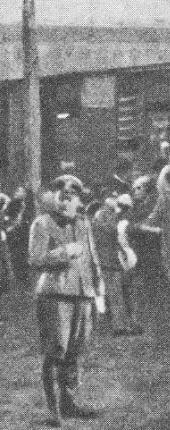 On the left is an animation of corresponding fragments from each of the three Umschlagplatz pictures, and demonstrates that no two of them are alike. Whether one gazes at the building above the train, the train itself, the pole, the officer, the ground � in every case the differences in going from one image to the next are so radical that retouching must be suspected, and perhaps retouching of an original painting rather than of an original photograph. Changes in brightness or contrast or blur which could result from alternative processing of one original photograph appear incapable of explaining the differences.
On the left is an animation of corresponding fragments from each of the three Umschlagplatz pictures, and demonstrates that no two of them are alike. Whether one gazes at the building above the train, the train itself, the pole, the officer, the ground � in every case the differences in going from one image to the next are so radical that retouching must be suspected, and perhaps retouching of an original painting rather than of an original photograph. Changes in brightness or contrast or blur which could result from alternative processing of one original photograph appear incapable of explaining the differences.
By the way, look for the two poorly-placed ink dots that are supposed to be the officer's eyes in the Levin version (which is the version with a building above the train, but without distinct windows). Notice also the deviation from perspective geometry in the white area on the side of the boxcar � its bottom is insufficiently slanted.
It would have been interesting to compare in all three Umschlagplatz pictures the cartoon figure standing on pencil legs that we noticed above; however, Alexander Donat has cropped this figure out entirely (which is one solution to the problem of a child's drawing appearing in what is supposed to be a Holocaust photograph), and Martin Gray places the pencil legs just off the picture, and plunges the entire area (near where the legs would have been) in blackness (which is piling on two solutions where either by itself would have sufficed).
The Umschlagplatz picture, then, gives the impression of having been created in order to lend credence to the image of civilians of both sexes boarding freight cars. If the Umschlagplatz picture were the only "photographic" evidence of this having happened, then one would have to conclude that no photographic evidence exists of this having happened (which, of course, is not the same conclusion as that it never happened).
A broader conclusion is that many historical images might benefit from scrutiny for doctoring or cropping, and even from verification that they are photographs and not paintings.
(4) Simon Wiesenthal Paints Smoke
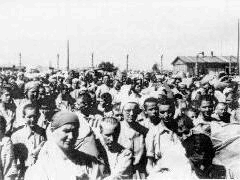 Outright forgery with intent to support a totally false conclusion can be see in the two images which comprise this animation.
Outright forgery with intent to support a totally false conclusion can be see in the two images which comprise this animation.
The smokeless photograph comes, without any caption, from a book by Peter Hellman, Lili Meier, and Beate Klarsfeld having the eyebrow-raising title of The Auschwitz Album: A Book Based Upon an Album Discovered by a Concentration Camp Survivor, Lili Meier (Random House, New York, 1981, photograph 143).
Sixteen years later, the smoking version of the photograph appears Copyright � 1997, The Simon Wiesenthal Center, 9760 West Pico Boulevard, Los Angeles, California 90035, published by the
Museum of Tolerance, and with the following caption, mistaken date included.
Hungarian arrivals after the "Selektion" at Auschwitz.
As these prisoners were being processed for slave labor, many of their friends and families were being gassed and burned in the ovens in the crematoria. The smoke can be seen in the background.
Date: June 0, 1944 Era: During WWII
On 21-Jun-1999, I wrote to Simon Wiesenthal, enquiring about the discrepancy between the photographs, but as yet have received no reply.
One notices, incidentally, that the smoking photograph bears the signs of forgery that we have remarked above � smallness of size, and darkening which blots out detail. It also bears the characteristic of internal invalidation � the poles can be seen to be too thin to be smokestacks, leaving no place for the smoke to be coming from.
(5) Simon Wiesenthal Borrows German Victims
Simon Wiesenthal glancing through the LIFE magazine issue of 11-Jun-1945 came across photographs of Germans who had been captured wearing American uniforms, and executed. Wiesenthal wanted to present these images to the world as Jews who had been tortured to death by Germans � but if he were to present the doctored photographs (they would have needed doctoring) as photographs, then he would be faced with the problem of having to explain how he, or any prisoner, had possession of a camera with film while inside the Mauthausen concentration camp, how he had succeeded in taking pictures clandestinely, how he had retained the film through the conclusion of the war, and so on.
Wiesenthal's solution to this problem was to doctor the photographs totally, not preserving, but rather destroying, their appearance as photographs, and then to present them as works of graphic art created shortly after the war from images stored in his photographic memory. Kill two birds with one stone � advance one's career as a Holocaust fabulist while earning credit as a graphic artist at the same time. The inevitability that his deception would be uncovered did not serve as a deterrent, as that required looking too far into the future, and in estimating probabilities more accurately, than Wiesenthal knew how to do.
In my letter to him of 18-Jan-1998, I have asked Simon Wiesenthal to explain the similarity between the LIFE magazine photographs of German victims and his own drawing of Jewish victims, but as yet have received no answer.
(6) The Waiting in Line Photograph
In my letter to you of 04-Sep-2000, I have already brought to your attention the first two of the five Waiting in Line photograph versions below, and in my letter to you of
29-Jan-2001, I talked of the Alexander Donat Figure 3, but did not actually reproduce it � rather, I reproduced Figure 1b again, intending thereby to remind you of the photograph in question, and as the subject of that letter was discrepant captions, not thinking it important which version of the photograph I reproduced.
However, now that the subject of discussion has become graphic doctoring and forgery, it turns out that the different versions of the Waiting in Line photograph are of immense importance, and I present below five versions originating from four sources. As I will shortly document, Donat's Figure 3 � alluded to in my second letter to you but not reproduced until now � will prove to be particularly different from the others.
It is vital to recognize at the outset what problems are faced by those who wish to use the Waiting in Line photograph to support their particular conclusions. Those wishing to portray the photograph as supporting the view of victims being � in Martin Gilbert's words below � "driven out of their houses, stripped, driven with guns and whips to the pits, and shot," will find incongruous and disconfirmatory that the leftmost mother and daughter look ahead of them calmly; for this reason, perhaps, this mother and daughter are cropped out in Figures 2 through 4. Similarly the lone woman on the far right hurrying to join the line is seen to not be driven forward by blows of clubs or lashes of whips, but rather is seen to be making her way unattended, and for this reason she too is incongruous and disconfirmatory. It helps a little to crop the area immediately behind her (as Martin Gilbert does in his Figure 2) so as to avoid having viewers wonder why the clubbers and whippers are not hard on her heels; and perhaps it helps even more to crop her out entirely (as Alexander Donat and Alan Levy do in their Figures 3 and 4) so as to avoid having viewers wonder why the clubbers and whippers are not at her side, or not hard on the heels of all the other women.
Those wishing to use the Waiting in Line photograph to support the conclusion that the scene is set in Treblinka, Poland rather than Ukraine are faced with an additional problem � the photograph shows the women in a ravine, and yet the Treblinka story does not include a ravine. Donat's Figure 3 addresses the problem in two ways � he makes the women taller so as to weaken the appearance that they are viewed from above, and he turns the grass on the near side of the ravine into flames � both of which can be appreciated more fully in the animation further below. Levy's Figure 4 imposes the most radical and effective solution � he crops severely both top and bottom, removing the view of the ravine altogether.
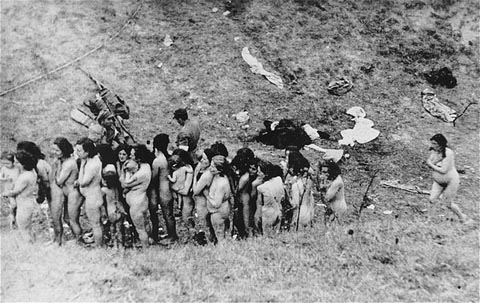
|
FIGURE 1a (USHMM small)
SOURCE:
Photograph from the Main Commission for the Investigation of Nazi War Crimes, courtesy of USHMM Photo Archives, published on the
20th Century History web site.
CAPTION:
Naked Jewish women, some of whom are holding infants, wait in a line before their execution by Ukrainian auxilliary police. (October 14, 1942)
COMMENT:
The underlying image on the 20th Century History web site � 480 pixels wide � was already smaller than it needed to be, or than it should be to permit accurate interpretation. Despite this, the image was presented at a forced width of only 400 pixels, as shown on the left, which hampered its interpretation further.
|

|
FIGURE 1b (USHMM large)
COMMENT:
The same image as above, but shown at the full 480 pixel width at which it was scanned. This is a step in the right direction, but far from adequate. Better would have been to give the viewer a choice of inspecting the image at widths in the order of 700, 1000, and 1300 pixels.
The only detail that might point to doctoring in the present version is what could be taken for a hat on the man facing left. As the hat might be taken for a military hat, this would reinforce the viewer's interpretation of this man as a guard. However, this appearance of a hat is not confirmed so clearly in Figure 3 below. Of course the question remains of which version of this particular detail is less doctored.
|
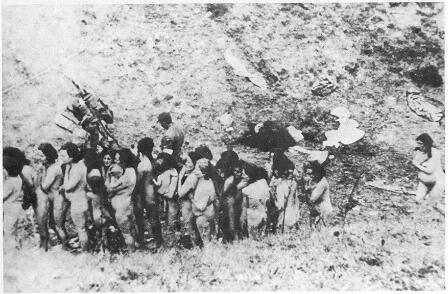
|
FIGURE 2 (Martin Gilbert)
SOURCE:
Martin Gilbert, The Holocaust: The Jewish Tragedy, Fontana/Collins, Glasgow, 1986, following p. 480.
CAPTION:
Jewish women and children, having been forced to undress, are led to the pit in which they will be killed. This photograph was taken at Misocz, in the Volhynia (page 178).
[And on p. 178 was the following text]
Such executions were now a daily occurrence throughout German-occupied Russia. No town, no village, no hamlet was spared the search for Jews to be driven out of their houses, stripped, driven with guns and whips to the pits, and shot. In the Volhynian village of Misosz a German cameraman recorded the last moments of a group of women and children being led to their execution.63
[p. 178. Discrepant spellings Misocz and Misosz were in the original.]
[And footnote 63 was the following]
Yad Vashem photographic archive.
COMMENT:
The resolution has deteriorated, and the photograph has been cropped on left, right, and bottom.
|
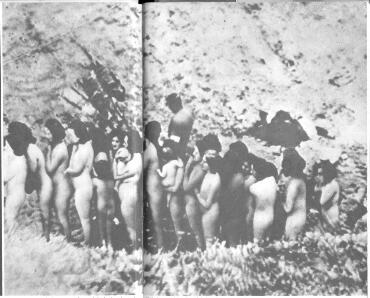
|
FIGURE 3 (Alexander Donat)
SOURCE:
Alexander Donat (Ed.), The Death Camp Treblinka: A Documentary, Holocaust Library, New York, 1979, pp. 260-261.
CAPTION:
[Caption to the left of photo] The Treblinka extermination camp. Mothers carrying children on their way to the gas chamber.
[Caption below photo] Naked women in front of the barber shop where their hair will be clipped before they are gassed.
COMMENT:
Resolution has deteriorated further. Cropping on the left has been reduced somewhat, but not enough to reveal that the foremost woman is holding a young girl, and that both mother and daughter appear calm. Cropping on the right is severe.
|
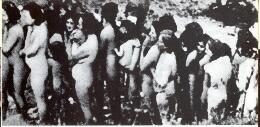
|
FIGURE 4 (Alan Levy)
SOURCE:
Alan Levy, The Wiesenthal File, Constable, London, 1993, following p. 128.
CAPTION:
Treblinka extermination camp.
COMMENT:
Severe cropping on left and right sharply limits the ability to interpret what is happening, and severe cropping at the top and bottom utterly conceals that the women are in a ravine, which is one way to solve the problem that the legend of the Treblinka death camp portrays Treblinka as flat. This version shows the greatest blurring, and the highest contrast, of any of the Waiting in Line photographs that we are examining.
|
In order to reveal that even the Waiting in Line photograph has not been safe from retouching or painting over, and from other distortions, I have placed an enlarged fragment from two versions (Gilbert's Figure 2 and Donat's Figure 3) into the animation below.
One of the biggest differences that leaps out from this animation is that the Donat photo has been expanded vertically so as to make the figures appear taller. The motive behind this vertical elongation might have been to conceal that the women are in a ravine, which is important to Donat to conceal because he wants the scene to be set in Treblinka, and the Treblinka legend portrays Treblinka as flat. One effect of the women really being in a ravine had been that they were viewed somewhat from above, which shortened their height in the photo. By expanding the photo vertically, Donat makes the women appear taller, thus weakening the impression that they are being viewed from above.
Another big difference is that Donat has painted over the grass so as to make it look like flames. One advantage is � again � to weaken the impression that the women are down in a ravine, an impression which in the undoctored photograph is suggested most strongly by the grass which can be seen hiding the women's feet, and by the foliage that can be seen superimposed on their legs. If this grass is taken to be flames, and if the foliage is removed, then the appearance of a ravine is weakened.
Now Donat does not say anywhere that the women in this photo are walking through, or beside, fire, and the Treblinka story does not typically depict victims doing so. However, I view Donat's Treblinka book as being low-budget and rushed, so that optimal images could not be ordered from master-craftsman of photographic deception. Rather, photos, some already doctored, were more likely hurriedly gathered from wherever was convenient, and any further doctoring was inexpert and rushed. Possibly, the version of the photograph that Donat ended up with had already been worked on by some forgery-factory hack whose ambition had been to turn it into a literal "holocaust" � that is, consumption by fire � scene. This project, however, might have been aborted when it was recognized that the women were not acting as if their feet were engulfed in flames, or as if they were about to be, leaving the doctored photograph up for sale at a bargain price which nobody would pay until Donat came along with his not very high budget and not very exacting standards.
Generally, by gazing at one spot in the animation and comparing the alternating images, the reader will be able to see many changes that the Donat version has introduced. A few of the bigger changes � by no means all � are indicated below the animation.
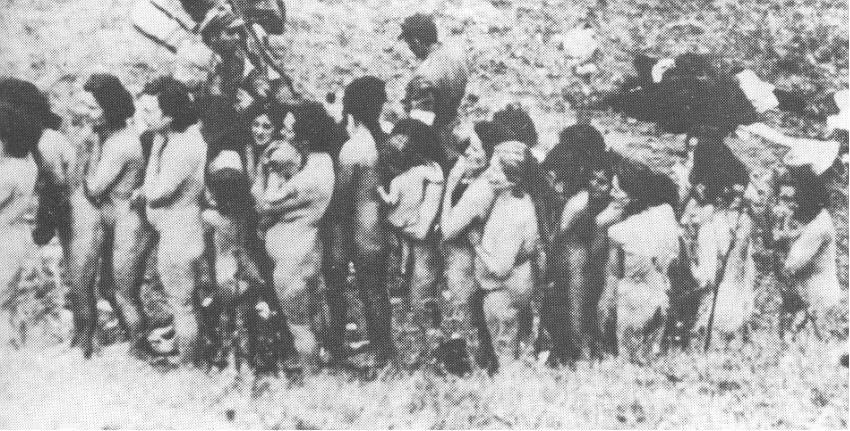
|
| |
1 |
|
2 |
|
3 |
|
4 |
|
5 |
|
6 |
|
7 |
| 1 Shadow of lower arm expanded. Woman in front loses the arch in her lower back. |
2 Both faces painted on. |
3 Face painted on; upper arm thinned; foliage across thigh erased. |
4 Face painted on; upper arm thinned; tummy tucked; foliage across thigh erased. |
5 Face painted on; ribs erased; natal cleft obscured. |
6 Branch erased; shoulder rotated leftward; natal cleft erased. |
7 Grass turned into flames, all the way from the left edge of the photo to the right. |
And so what do we conclude from the Waiting in Line photographs above?
- That as the meaning attributed to the photograph is sometimes false, then all meanings that have been attributed so far may be false.
- That as cropping is sometimes used to help adapt the photograph for alternative uses, then even the least cropped version that has been released for public inspection may itself have been already cropped so as to conceal what the people in the photograph were really doing.
- That as small size and blurring and excessive contrast are sometimes employed to obscure meaning, and as no large and sharp and detailed version is available to the public, the public is being denied the evidence it needs to interpret the photograph.
- That as some versions are doctored, then those who control the original photograph permit doctoring, as by not issuing notices of inauthenticity when they see doctored versions being disseminated.
(7) The Marchenko Pointing Photograph
Following the world's recognition that John Demjanjuk was not Ivan the Terrible of Treblinka, the Israeli prosecutors decided to at least save the idea that there had been some Ukrainian Ivan the Terrible of Treblinka, and that their mistake had been the minor one of thinking that it was Ivan Demjanjuk when in reality it had been Ivan Marchenko.
From the point of view of Jewish-holocaust propaganda, one story was almost as good as the other. Too bad about the initial mistake (which cost John Demjanjuk seven years in solitary confinement in Ayalon Prison � to speak of no more than his suffering within Israel), but Jews could still cash in on being big enough to admit they were wrong. In this way, the major blunder of believing in any Ivan the Terrible of Treblinka when there had been none would not have to be acknowledged, and the major inconvenience of having a living defendant denying accusations could be avoided as well, as Ivan Marchenko was dead.
A further advantage of framing Ivan Marchenko was that his relatives could be counted upon to not raise much of a fuss � they were impoverished villagers a thousand miles inside the Iron Curtain. Their totalitarian state supported the myth of Ivan the Terrible Marchenko of Treblinka, and would come crashing down on them if they preferred not to. In any case what could prompt them to object? They would be uninformed concerning what was being said about their paterfamilias in the West. They wouldn't have the means to do any research of their own. And in the unlikely event that they did raise some peep of an objection, there would be nobody to listen to them. To the problem of the world not believing the U.S. Office of Special Investigation's, and Israel's, story of Ivan the Terrible Demjanjuk of Treblinka, Ivan the Terrible Marchenko of Treblinka was not at all a bad solution.
In support of this new theory, there was widely circulated the photograph below, said to be of Ivan Marchenko (the taller man pointing with his finger) together with companion Ivan Tkachuk (pointing with a gun). But just how does this photograph support the theory of Ivan the Terrible Marchenko of Treblinka? It is not at all clear how. Perhaps � if it is granted that the finger pointer is indeed Ivan Marchenko � it gives the impression that the Israelis are well armed with documentation concerning Marchenko's past, and it puts Marchenko in uniform, and also together with another uniformed Ukrainian. Pretty weak stuff to buttress a genocide charge, but when buttressing is desperately needed, one takes whatever one can get.
Israeli agent Yoram Sheftel � who duped the Demjanjuk family into giving him control of the Demjanjuk defense � ascribes greater significance to this photograph than I have indicated above. Sheftel says that the photograph places Ivan Marchenko at the Trawniki training camp (alternatively spelled "Travniki") � his caption being the one I reproduce below the photograph. However, this geographical placement is plainly false. The photograph is obviously taken within a home, perhaps in a bedroom. Thus, we see a polka dot cover, possibly on a bed � where polka-dot bedspreads were perhaps not standard German military issue. There is a plant, an embroidered table cloth, a picture (perhaps religious) on the wall and maybe a cross, curtains � items that show the touch of feminine, or at least civilian, hands, and that would be alien to a military barracks. There are no military furnishings or paraphernalia. If this is the inside of a Trawniki barracks, it would force us to revise our views of German military life. Furthermore, if these are two Ukrainians at the same training camp, then we would expect them to be wearing the same uniform, which they are not � their caps are different, their pants are different, their jackets differ at least in brightness.
But to return to the subject which is the concern of this letter, the Marchenko Pointing photograph gives indications of being forged:
Implausibility. We have, in the first place, implausibility of content. What in the world might these two individuals be doing, inside somebody's bedroom, one pointing his finger and the other pointing a gun? One cannot imagine. The pose is artificial. These guys must be horsing around. And yet does a military man horse around in someone's house by drawing his pistol and pointing it? Neither of them has a holster, so where did the gun come from? This photograph makes no sense.
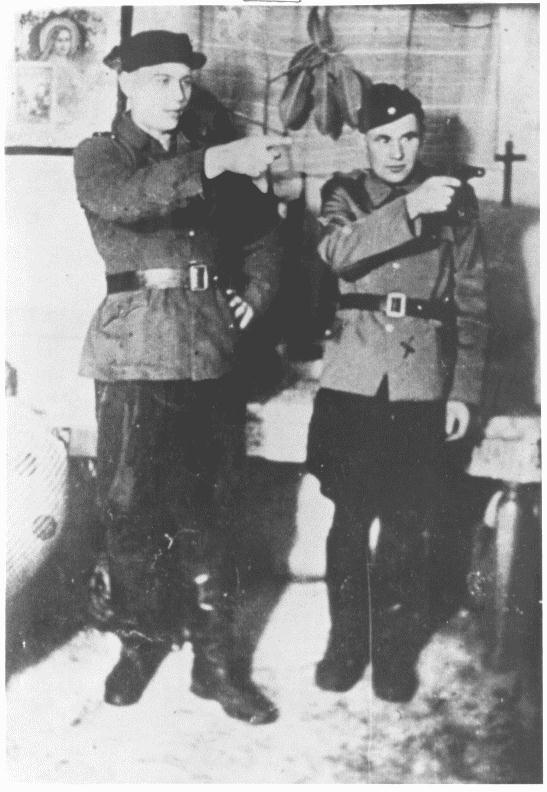
Ivan Marchenko (the taller figure) with Ivan Tkachuk, at Travniki.
[Photograph and caption are from Yoram Sheftel, The Demjanjuk Affair: The Rise and Fall of a Show Trial, Gollancz, London, 1994, following p. 176.]
|
|
Men pasted from different photographs. The two men look like they've been pasted in from different photographs. We get this impression first from their great difference in size � in comparison to Marchenko, Tkachuk is a midget. If Tkachuk looked straight across toward Marchenko, he'd be staring at Marchenko's collar bone. And not just Tkachuk's person, but his apparel is miniaturized as well, which we see by comparing Marchenko's man-sized belt and buckle to Tkachuk's midget ones. One way this size discrepancy could have arisen is through careless scaling of images prior to pasting.

 As can be seen on the right, scaling the two men so that they're closer to equal in size gives peculiar results. Now Tkachuk's belt can be seen to be hitched up around his rib cage. His feet become too wide. Placing him within a tall, narrow rectangle reveals that he is tipping over to the right. If the photograph were rotated counter-clockwise so as to straighten Tkachuk, then Marchenko would be tipping over backwards. At best Tkachuk is awkward; at worst he is a composite.
As can be seen on the right, scaling the two men so that they're closer to equal in size gives peculiar results. Now Tkachuk's belt can be seen to be hitched up around his rib cage. His feet become too wide. Placing him within a tall, narrow rectangle reveals that he is tipping over to the right. If the photograph were rotated counter-clockwise so as to straighten Tkachuk, then Marchenko would be tipping over backwards. At best Tkachuk is awkward; at worst he is a composite.
And not only are the two men of different size and wearing different uniforms, but they appear to be under different lighting. For example, Marchenko has a blinding glare on his belt, and Tkachuk has almost none; Marchenko shows folds in his pants, Tkachuk's jodhpurs are immersed in unrelieved blackness; Marchenko shows glare on his boots, Tkachuk almost none; Marchenko shows wrinkling and texturing in his jacket, Tkachuk's looks like it has just been laundered in phosphorescent detergent, starched, pressed, and is now glowing under ultraviolet light. Can two companions in arms standing side by side have such different optical characteristics?
High contrast. That tell-tale of primitive forgery � high contrast � is amply present, giving areas too bright or too dark to contain information. Look, in particular, at that black mass sitting on Marchenko's left shoulder and extending down his left arm � there is nothing in the world that this is as likely to be as a forger running out of ideas, or talent, or just time, and inking in blackness which he hopes will be taken for shadow.
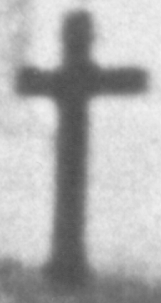 The cross. In the first place, this cannot be a shadow, as there is nothing that it could be a shadow of. If it is something that is present in the room (and not drawn on the negative or on a print), then it must be an object right on the wall, and yet it has no internal detail or shading or texture. Rather, it has the characteristics of ink lines: the edges are not very straight, the tips are rounded (in fact there are blobs at the ends), there is bleeding from one line to the other at the point of intersection.
The cross. In the first place, this cannot be a shadow, as there is nothing that it could be a shadow of. If it is something that is present in the room (and not drawn on the negative or on a print), then it must be an object right on the wall, and yet it has no internal detail or shading or texture. Rather, it has the characteristics of ink lines: the edges are not very straight, the tips are rounded (in fact there are blobs at the ends), there is bleeding from one line to the other at the point of intersection.
The lower arm is too long. The left arm is too short � which would be understandable if the tip of that arm were hidden under the curtain, but then why would the left-hand end-blob not be hidden under the curtain also, but rather start to the right of the curtain?
And the position on the wall � actually touching the curtain! No one would mount a cross here on a real wall; but an inept forger � penning bleach on a small negative or penning ink on a small print � might place a cross here because it would then be nicely centered between Ivan Tkachuk's pistol and the edge of the photograph.
Speaking of crossed ink lines � the photograph might contain another set, in the form of an X, on Tkachuk's iridescent jacket, below his matte-finish belt.
It suddenly occurs to me that what this photograph may have originally intended is to show Marchenko and Tkachuk (or whoever they are) both pointing � one with his finger, the other with his gun � at a cross which is not flat against the wall beside them, but rather floating in the air in front of them. At least this gives the photograph a coherence that it previously lacked, though at the cost of replacing the mystery of incoherence with the mystery of what mind could have found satisfaction in such a scene, and set about forging it.
Tkachuk's pistol. Below are presented five WW II pistols as they were photographed in action. Sometimes, the original photograph was small or blurred, so that my enlargement below is not of high quality, which, however, may not be a liability, as my purpose is to make comparison to the Tkachuk pistol image, which is also not of high quality. What we see in the five WW II photographs is common characteristics which clash with the rendering of the Tkachuk pistol. For one thing, the brightness of real pistols and hands approximately corresponds (and one case demonstrates that the pistol can be brighter); but the Tkachuk pistol is mostly pure black and the Tkachuk hand is mostly pure white. Thus, where the real pistols contain internal detail; the Tkachuk pistol is undifferentiated blackness. The real pistols have prominent front sights; the Tkachuk pistol does not. The real pistols have a complex silhouette; what can be seen of the Tkachuk pistol silhouette is too simple to be credible, and much of the silhouette is invisible against the black background. In short, the real pistols gain credibility because they would be hard to forge and because they are alike; the Tkachuk pistol loses credibility because it is easy to forge and because it is different.
Five Credible Photographs of WW II Military Pistols, and Ivan Tkachuk's
|
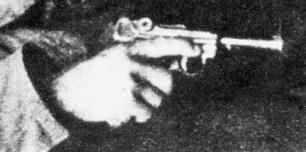
German, Luger
Keith Simpson, Waffen SS, Bison Books, London, 1990, p. 33.
|
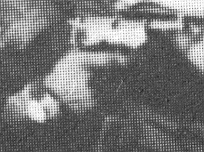
Held by member of the French Resistance
Hannah Vogt, The Burden of Guilt: A Short History of Germany, 1914-1945, Oxford University Press, New York, 1964, p. 236.
|
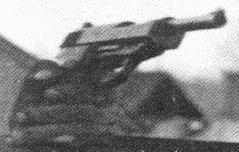
German, Walther P38
Gordon Williamson, The SS: Hitler's Instrument of Terror, Motorbooks International, Osceola Wisconsin, 1994, p. 204.
|
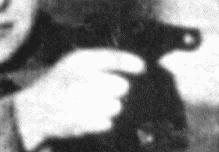
Ivan Tkachuk's pistol bears little resemblance to any of the others, and in comparison to them, is easy to forge.
|
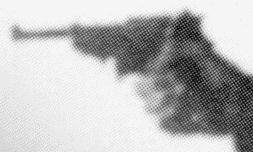
Held by Soviet soldier, possibly of German manufacture
Gordon Williamson, The SS: Hitler's Instrument of Terror, Motorbooks International, Osceola Wisconsin, 1994, p. 183.
|
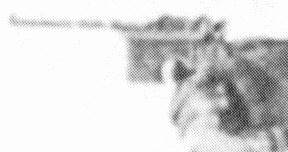
Held by Soviet soldier, possibly Mauser
Gordon Williamson, The SS: Hitler's Instrument of Terror, Motorbooks International, Osceola Wisconsin, 1994, p. 183.
|
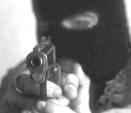
From Ukrainska Pravda
www.pravda.com.ua
18-Jan-2001
|
In order to better evaluate the single bright glare spot at the end of Tkachuk's pistol, I locate a contemporary photograph of a pistol in which the barrel does not protrude substantially from the housing, and in which the aim is directed closer to the camera. We see in this new photograph that the strongest glare originates from the outside rim of the barrel, which does approximately conform to what we see on Tkachuk's pistol. However, we also see that the shape of this primary glare is closer to a fine line than to a round spot, and we also see glare coming from other locations on the pistol, as for example from the housing as well as from the inside rim of the barrel. Additional comparisons to real photographs of real pistols, we might extrapolate, serve only to further undermine the credibility of the Tkachuk pistol.
The conclusion reinforced by examining the Marchenko Pointing photograph, then, is that it too is likely to be the product of doctoring or forgery, and thus, more broadly, that doctoring and forgery today undermine the credibility of a disturbing volume of Jewish-holocaust-related photographic material.
The above cannot be taken as an exhaustive review of Jewish-holocaust doctoring and forgery. Rather, it is a sampling of material that I have at hand in a personal library that is small, as my interest in the Jewish holocaust is both very recent and highly peripheral. As I concentrate in this letter mainly on doctoring and forgery, and not on misrepresentation of meaning, I do not include here documentation of TIME Magazine's misrepresentation of the Wallowing Girl photograph, where doctoring � though unmistakably embarked upon � does not appear to have progressed to a point where it played any role.
|
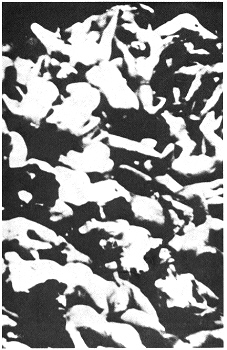
Corpses of victims asphyxiated in the gas chambers. [Image and caption from Alexander Donat (Ed.), The Death Camp Treblinka: A Documentary, Holocaust Library, New York, 1979, p. 262]
|
In view of the evidence presented above, then, the United States Holocaust Memorial Museum (USHMM) might feel itself called upon to undertake at least the following measures:
- The USHMM should review all Jewish-holocaust photographic materials, and should reject any that show signs of tampering, or at least should publicly identify them as suspect. As an urgent first step, the USHMM should teach Jewish-holocaust scholars to distinguish photographs from paintings.
- The USHMM should publish an unbroken chain of custody with every photograph, and acknowledge that any break in the chain weakens the photograph's credibility. As an urgent first step, the USHMM should teach Jewish-holocaust scholars that riffling through Yad Vashem photographs of unknown origin in order to find any that the public might accept as corroborating whatever story happens to be in preparation constitutes historical fraud.
- Where multiple versions of a photograph exist, the USHMM should determine which is the most authentic, and publicly identify all others as suspect or inauthentic. As an urgent first step, the USHMM should disabuse Jewish-holocaust scholars of the naive notion that one version of a photograph is as good as another, and replace that misconception with the understanding that different versions fall at different positions along a continuum of fidelity.
- The USHMM should make available online large and sharp and uncropped and in every way optimized versions of all photographs in its archives. As an easy first step, the USHMM could stop forcing images to be displayed online at a smaller size than they were scanned.
- The USHMM should publish standards for the reproduction of historical photographs, which standards should include an absolute prohibition on cropping and on any degrading of information, as by heightening contrast, by blurring, and most certainly by doctoring.
- The USHMM should assume a leading role in implementing a boycott by publishers of historical images that are in any way modified or degraded in comparison with the best originals.
- The USHMM should include among its educational displays animations like those presented above, which would serve to underline the importance of protecting truthful accounts of the Jewish holocaust from being displaced by fictional ones. A first step that can be implemented within minutes would be for the USHMM web site to link to the present letter.
- The USHMM should recognize the damage that is being inflicted on Jewish credibility by Jewish-holocaust fabulists, and should consider whether the psychiatric diagnosis of "anti-Semitic" � if its use is to continue at all � should be applied more often to those who injure the Jewish people by spreading falsehoods in their name, and less often to those who assist the Jewish people to purge themselves of falsehood.
- The USHMM should recognize the indispensibility of sifting Jewish-holocaust documentation through the sieve of forensic science, and so should to some degree replace as a qualification of employment the attribute of ideological zeal with the attribute of laboratory competence.
Failure to institute measures against the continuing corruption of documents brings promise of drowning Jewish-holocaust history under an ocean of disinformation, which in the graphic realm would manifest itself increasingly in creations such as the one above, which comes with no attribution, which is so cropped that no context is discernible, whose optical contrast is raised to such a degree that most of the shapes are unrecognizable, whose forgeability is easy, and whose credibility is nil. The Damocles Sword that such images poise over the head of the Jewish people is the threat of eventual discovery that the origin of the images has been concealed, and their content obscured, because it was known that the images had nothing to do with WW II.
Lubomyr Prytulak
HOME
DISINFORMATION
PLUNDER
PLUNDER VICTIMS
PEOPLE
GREENBERG

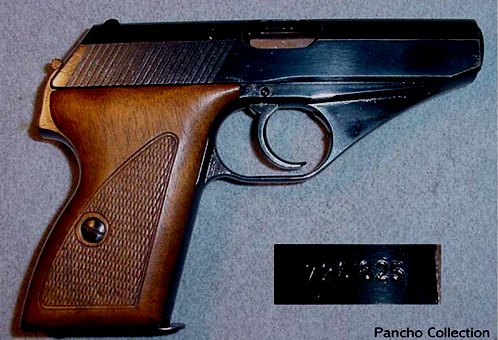


 The Newseum: The Interactive Museum of News presents the documentary, The Commissar Vanishes: The Falsification of Photographs in Stalin's Russia), in which examples are offered of Soviet doctoring of photographs. I have placed two of these photographs into the animated image on the left so as to facilitate perception of the differences between them. It can be seen that not only has Trotsky been removed from Lenin's left, but three other individuals have been purged along with him.
The Newseum: The Interactive Museum of News presents the documentary, The Commissar Vanishes: The Falsification of Photographs in Stalin's Russia), in which examples are offered of Soviet doctoring of photographs. I have placed two of these photographs into the animated image on the left so as to facilitate perception of the differences between them. It can be seen that not only has Trotsky been removed from Lenin's left, but three other individuals have been purged along with him. On the left appears to be a photograph of a Nazi military parade presented by Keith Simpson, Waffen SS, Bison Books, London, 1990, p. 6. What appears to be the same photograph is presented also as the frontispiece in Gordon Williamson, The SS: Hitler's Instrument of Terror, Motorbooks International, Osceola WI, 1994. However, placing a fragment from each of these within the animation below suggests that what appeared to be photographs are closer to drawings or paintings, perhaps superimposed on some original photograph.
On the left appears to be a photograph of a Nazi military parade presented by Keith Simpson, Waffen SS, Bison Books, London, 1990, p. 6. What appears to be the same photograph is presented also as the frontispiece in Gordon Williamson, The SS: Hitler's Instrument of Terror, Motorbooks International, Osceola WI, 1994. However, placing a fragment from each of these within the animation below suggests that what appeared to be photographs are closer to drawings or paintings, perhaps superimposed on some original photograph.
 Nora Levin, (The Holocaust: The Destruction of European Jewry, 1933-1945, Crowell, New York, 1968, following p. 346) wrote the following caption for the Umschlagplatz picture:
Nora Levin, (The Holocaust: The Destruction of European Jewry, 1933-1945, Crowell, New York, 1968, following p. 346) wrote the following caption for the Umschlagplatz picture: On the left is an animation of corresponding fragments from each of the three Umschlagplatz pictures, and demonstrates that no two of them are alike. Whether one gazes at the building above the train, the train itself, the pole, the officer, the ground � in every case the differences in going from one image to the next are so radical that retouching must be suspected, and perhaps retouching of an original painting rather than of an original photograph. Changes in brightness or contrast or blur which could result from alternative processing of one original photograph appear incapable of explaining the differences.
On the left is an animation of corresponding fragments from each of the three Umschlagplatz pictures, and demonstrates that no two of them are alike. Whether one gazes at the building above the train, the train itself, the pole, the officer, the ground � in every case the differences in going from one image to the next are so radical that retouching must be suspected, and perhaps retouching of an original painting rather than of an original photograph. Changes in brightness or contrast or blur which could result from alternative processing of one original photograph appear incapable of explaining the differences. Outright forgery with intent to support a totally false conclusion can be see in the two images which comprise this animation.
Outright forgery with intent to support a totally false conclusion can be see in the two images which comprise this animation.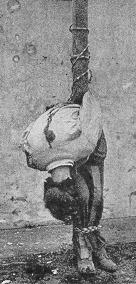
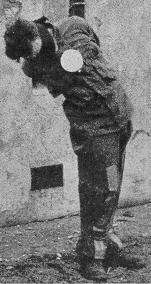
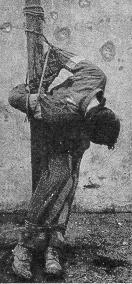
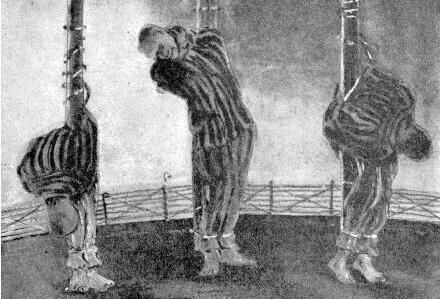








 As can be seen on the right, scaling the two men so that they're closer to equal in size gives peculiar results. Now Tkachuk's belt can be seen to be hitched up around his rib cage. His feet become too wide. Placing him within a tall, narrow rectangle reveals that he is tipping over to the right. If the photograph were rotated counter-clockwise so as to straighten Tkachuk, then Marchenko would be tipping over backwards. At best Tkachuk is awkward; at worst he is a composite.
As can be seen on the right, scaling the two men so that they're closer to equal in size gives peculiar results. Now Tkachuk's belt can be seen to be hitched up around his rib cage. His feet become too wide. Placing him within a tall, narrow rectangle reveals that he is tipping over to the right. If the photograph were rotated counter-clockwise so as to straighten Tkachuk, then Marchenko would be tipping over backwards. At best Tkachuk is awkward; at worst he is a composite. The cross. In the first place, this cannot be a shadow, as there is nothing that it could be a shadow of. If it is something that is present in the room (and not drawn on the negative or on a print), then it must be an object right on the wall, and yet it has no internal detail or shading or texture. Rather, it has the characteristics of ink lines: the edges are not very straight, the tips are rounded (in fact there are blobs at the ends), there is bleeding from one line to the other at the point of intersection.
The cross. In the first place, this cannot be a shadow, as there is nothing that it could be a shadow of. If it is something that is present in the room (and not drawn on the negative or on a print), then it must be an object right on the wall, and yet it has no internal detail or shading or texture. Rather, it has the characteristics of ink lines: the edges are not very straight, the tips are rounded (in fact there are blobs at the ends), there is bleeding from one line to the other at the point of intersection.






